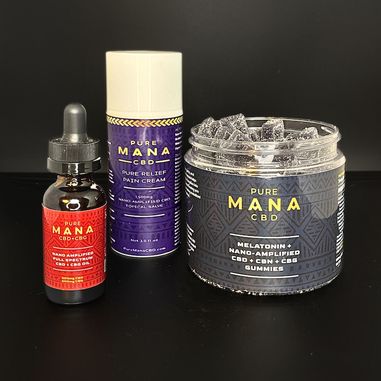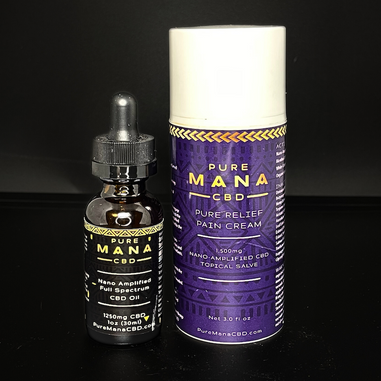How Can CBD Bring Relief?

CBD (cannabidiol) is a natural compound extracted from the hemp plant. It doesn’t get you high, it has zero harmful side effects, and is known for its mental and physical health benefits.
CBD works with your Endocannabinoid System (ECS) to keep all your systems operating at their best and maintain a healthy internal balance. CBD uses your ECS to organize messages from various sources in your body, prioritizing the important parts and filtering out junk mail.
CBD and the ECS interact with every system and function of your body, including pain management. This article will explore how CBD interacts with pain, what kinds of pain it’s most effective for, and when and how it should be used for best results.

Let’s start by defining pain. What exactly is pain?
CRITICAL ALERT:
Pain is a symptom.
It’s not the error itself. It’s just an error message.
Pain is a SHOUTING signal your body sends your brain to let it know there’s something wrong. Like all screaming matches, it’s usually indicative of a deeper, underlying problem.

If you put your hand on a hot stove, the nerves in your fingertips immediately send a yelling message to your brain that says, “OUCH!!!”
You can choose to respond to that message any way you like. You can leave your hand on the stove and pop an aspirin for the pain. You can put ice on your sizzling handburger while your fingerprints melt together (you may need a lot of ice.) Or, you can take your hand off the stove.

Meds for Pain
When you take pain medication, you’re choosing to only listen and respond to the “OUCH!!!” when what the message really means is: “SOMETHING’S WRONG, FIX IT!!!” You’re taking care of the temporary symptom and pushing the actual problem forward for Future You to deal with later.
Most over-the-counter pain relievers are like Band-Aids for bullet holes. They click the little ‘X’ above the error message and hope the actual error goes away too.
They hear “OUCH!!!” and they respond: “SHHHH!!!”

CBD for Pain
Unlike prescription medications, CBD targets the source of the pain, soothes it, and helps prevent it from happening. It also addresses the symptoms your pain may have caused, such as inflammation, nerve damage, and poor sleep.
CBD gives your Endocannabinoid System (ECS) the resources it needs to identify the dysfunction or imbalance that’s causing pain and helps bring it to balance. Since the ECS regulates all your body’s systems, this healing effect can reach every function of your body, including your pain management, immune system, energy, sleep, nervous system, and even your mood.
50 SHADES OF PAIN
Not all pain is created equal.
We can classify pain with two useful scales: Damage and Duration (there’s some overlap between the two).

Damage
- This includes cuts, broken bones, burns, headaches, toothaches, and even some kinds of arthritis.
- It also includes pain from organ damage, like cirrhosis, and most pain from surgeries and childbirths.
- Pain from inflammation is also considered nociceptive. It starts with tissue damage that causes swelling, which can cause pain when it pushes against sensitive nerve endings.

Pain caused by nerve damage is called neuropathic pain.
- Nerves are commonly damaged by brain or spinal injuries
- They can also be damaged by a stroke or chemotherapy.
- This includes nerve damage from diseases like diabetes, MS, Alzheimer’s, Parkinson’s, shingles, tumors, and HIV.

Pain that had a physical origin but has been prolonged by mental, emotional, or behavioral factors is called psychogenic pain.
- Psychogenic pain can originate from either nociceptive or neuropathic pain.
- This includes physical pain stemming from fear, stress, anxiety, or depression.

Duration
Short-term pain is called acute pain.
- It usually starts abruptly and sharply, then gradually goes away.
- It tends to come from tissue damage in a specific location.
- It generally lasts less than six months.
- It should disappear once you find and treat the cause.
- Most acute pain is nociceptive.

Long-term pain is called chronic pain.
- This usually includes any pain that lasts longer than six months.
- Pain from inflammation is generally considered to be chronic nociceptive pain.
- Chronic pain can be nociceptive, neuropathic, or psychogenic. In fact, most neuropathic and psychogenic pain is chronic.
- An estimated 50 million adults in the USA live with chronic pain.
THE ROOT CAUSE: HOW TO TURN OFF THE STOVE
CBD is effective for most kinds of pain.
Unlike pain medication, CBD has zero harmful side effects and won’t damage your liver or other vital organs.
It’s also non-psychoactive, non-addictive, and you won’t have to keep escalating your dosage just to get the same effect.

Nociceptive Pain
Many current studies show CBD is better than placebo for treating nociceptive pain. That means the effects aren’t just in your mind.
CBD tells your body to pump a truckload of bliss-inducing endocannabinoids into the pain control center of your brain. At the same time, it disables the enzymes that usually break the endocannabinoids down, which helps the effect last longer.
You can directly control this effect by increasing or decreasing your CBD dosage.

Chronic and Neuropathic Pain
Where CBD really shines is with chronic and neuropathic pain. Cannabidol helps manage an important pain relay station in your spine that’s in charge of filtering pain signals from the rest of your body.
Most other pain medications work by just numbing the pain signal. CBD seems to work up and down the neural pathways in your brain and spine to find and soothe the root causes of these long-term pains.

Inflammation
CBD helps your ECS regulate your inflammation levels and maintain a healthy balance.
If you have an injury that causes pain, which causes inflammation, which causes more pain, CBD can help break that vicious cycle. Consuming CBD or rubbing it on an inflamed area can desensitize the nerve endings and help bring the inflammation under control.

Nerve Damage
One of CBD’s most well-documented superpowers is its preventative properties against the nerve damage that causes neuropathic pain.
Using CBD preventatively at the onset of a neurodegenerative disease has been shown to protect from a lifetime of excruciating chronic pain. CBD can help combat nerve damage from diabetes, osteoarthritis, Alzheimer’s, Parkinson’s, and even chemotherapy.

Acute Pain
CBD helps with acute (temporary) pain, but stops short of blocking the pain signal completely. This means you won’t have to worry about accidentally hurting yourself without noticing.
There’s evidence indicating that CBD can work with a part of the brain that controls pain perception to help quiet psychogenic pain and keep acute pain from turning chronic (long term).

Sleep
CBD is famous for helping with all kinds of sleep issues. It helps you fall asleep and get a full night’s rest in spite of your pain.
Dosage
CBD may interact with certain medications, so talk to your doctor if you’re currently taking antidepressants, antibiotics, or any medication with a ‘grapefruit warning’.
There’s no lethal, harmful, or toxic dose of CBD.
A few people have reported minor side effects like nausea or diarrhea when taking large doses of CBD oil. These should be temporary, and studies indicate it might be from the oil rather than the cannabidiol itself.
What the Research Says: CBD vs Pain
CBD vs Neuropathic Pain
Pain perception is a two-way street. Ascending pain pathways go from your nerve endings, up your spinal cord, to your brain. Descending pain pathways start from your brain, go down your spinal cord, and end in your nerve endings. This allows both your king brain and your working-class nerves to have some say in how much pain you need to feel.
The Periaqueductal Grey (PAG) is the part of your brain that controls many of your descending pain pathways. CBD significantly elevates endocannabinoid levels in the PAG. This produces an antinociceptive (pain blocking) effect that directly correlates with the CBD dosage.
CBD vs Neuropathic Pain
An important relay station for neuropathic and chronic pain is the lamina II of the spinal dorsal horn. It’s responsible for filtering ascending pain impulses and integrating them with other important information. This area is teeming with α3-containing glycine receptors (α3 GlyRs). Intrathecal administration of CBD and DH-CBD has been shown to target α3 GlyRs in mice, producing a powerful inhibitory effect on chronic neuropathic pain.
CBD vs Chronification
Chronification is when acute pain turns chronic. Dysfunctional descending pain pathways play an important role in pain chronification. Elevating PAG endocannabinoid levels with CBD can help to bring your descending pain pathways back into homeostasis and avoid chronification.
CBD vs Pain: Rapid-Fire Round
- Endocannabinoids like anandamide and 1-AG produce short-lived pain relief. They are quickly broken down by their nemesis enzymes FAAH and MAGL. CBD stops FAAH and MAGL from breaking down endocannabinoids. This allows for longer and stronger pain-relieving effects.
- VR1 receptor stimulation is another channel that causes pain and inflammation. CBD binds to these receptors, desensitizing them, & producing anti-inflammatory and analgesic (anti-pain) effects.
- Adenosine is a neuromodulator that, among other things, promotes sleep and suppresses inflammation and pain. The equilibrative nucleoside transporter (ENT) family is a group of proteins that transport chemicals like adenosine between cells. CBD inhibits ENTs. This decreases adenosine absorption, allowing its pain suppressing effects to last longer.
- CBD displaces the 5-HT1A receptor agonist, another descending pain pathway.
- At micromolar concentrations, CBD has been shown to inhibit the absorption of other common feel-good chemicals like norepinephrine, dopamine, and serotonin (in cultured cells), extending their soothing effects.
CBD vs The Vicious Cycle of Inflammation
- Joint tissue damage causes pain and fires up localized TRPV1 immunoreactivity. You feel this when a joint injury starts to swell up and feels warm to the touch.
- TRPV1 expression activates synoviocytes, which begin to release lubricating fluid and pro-inflammatory cytokines
- Cytokines sensitize nerve endings and increase TRPV1 expression, causing more pain and inflammation.
- Topical CBD application desensitizes TRPV1 expression, which can help interrupt this escalating cycle.
CBD vs Nerve Damage
- Localized use of CBD helps protect from the development of pain and nerve damage in osteoarthritic joints.
- When cells were exposed to CBD prior to their exposure to beta-amyloid peptide (which causes Alzheimer’s) cell survival increased and a decrease in lipid peroxidation, intracellular calcium, caspase 3 levels, DNA fragmentation, and ROS production was seen.
- CBD helps protect neurons against the progressive degeneration of nigrostriatal dopaminergic neurons and striatal atrophy that occurs in Parkinson’s disease. Prior application of CBD leads to an up-regulation of mRNA levels of Cu/Zn-superoxide dismutase, a key enzyme in endogenous defense against oxidative stress.
- Paclitaxel (PAC) is a cause of chemotherapy-induced neuropathic pain. CBD helps prevent PAC-induced mechanical sensitivity, mediated in part by the 5-HT1A receptor system.
- Strong doses of intranasal CBD at the onset of diabetes helps decrease the development of a neuropathic pain state, even after discontinuation of treatment.
Summary:
CBD helps with various types of pain. It helps bring your body and mind into balance while soothing the source of the pain and preventing it from recurring.
CBD also addresses the symptoms your pain may be causing, such as inflammation, nerve damage, sleep issues, and mood imbalances.
CBD has zero harmful side effects and is a natural, effective alternative to pain medications.







